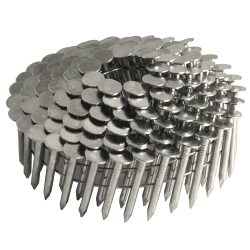
Discover exceptional fastening power and endurance with Grip-Rite® collated roofing nails. When paired with shingles, these fasteners provide an excellent, secure attachment. Rely on us to provide the best collated roofing nails that offer durability, strength and corrosion resistance without compromising efficiency and speed. Coiled roofing nails are easy to use while on a roof or ladder.
With precise engineering for roofing applications, you can rely on our collated roofing nails to offer the following features:
Collated nails have two main angles:
They may have one of three treatments, platings or coatings:
Our coiled roofing nails offer fantastic benefits, including:
Clear up some of your questions about coil and collated roofing nails with our answers to frequently asked questions.
Collated roofing nails offer significant benefits, including increased efficiency, improved accuracy and reduced waste. Most collated nails for roofing installations are also corrosion- and weather-resistant.
Hot-dipped nails are better for roofing since they offer more comprehensive protection against corrosion and weather exposure. Electrogalvanized nails provide good coverage but not nearly as good as hot-dipped nails.
Collated roofing nails offer excellent efficiency. Find a dealer near you and elevate your roofing.